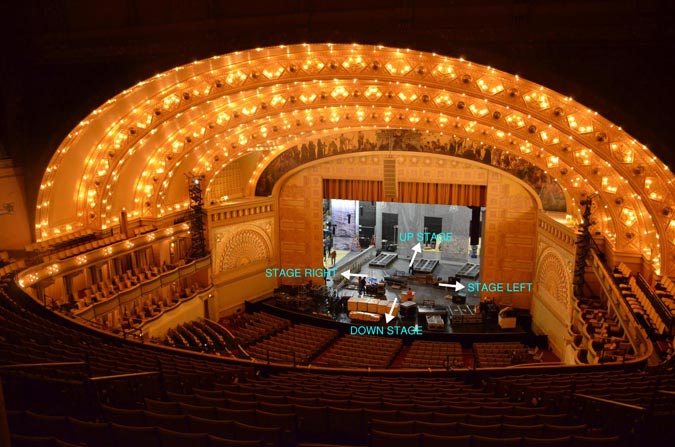Did You Know – Stage Directions
By Paul G. Sanow, ASTC
Stage Left and Stage Right are simple and always from the point of view of the performer. When a performer addresses the audience directly, Stage Right is to the performer’s right, and Stage Left to their left. Performers, technicians, and really everyone immersed in this work know this reflexively. Personally, I can’t often recall the direction of north in a windowless theatre, but I know where to find Stage Right, with my eyes closed.
Up Stage and Down Stage are a bit trickier, yet again well understood within the industry. In the past stages were raked or sloped in many theatres, with the lower portion being the front of the stage, and rising toward the back. For a performer standing at the center of the stage looking at the audience, if they walk forward, they are moving “down stage”. Raked stages were used to improve sight lines for the audience, and the slope could be substantial. There are some theatres which still have a raked stage such as Ford’s Theatre in Washington, D.C, though that slope is fairly gentle at less than one half inch per foot. Raked stages are still used to this day as a scenic concept, typically built up over the flat, fixed stage, contributing to a natural vanishing point for scenery designed with “forced perspective”, creating a greater sense of depth.
These directions can also be combined, so a performer moving down stage right is moving diagonally toward the audience and stage right. Stage Directors, choreographers, designers and technical staff also use these terms almost exclusively.
So now you know what we are thinking when we say, “Please move that box three feet stage left”.
THEATRE LOGIC
Author Unknown – Contributed by Andrew Gibbs, ASTC
- In is down, Down is front.
- Out is up; Up is back.
- Off is out, On is in, and, of course, Right is left and Left is right.
- A Drop should not, and a Block and Fall does neither.
- A Prop does not, and a Cove has no water. (Unless the building is flooding.)
- Tripping is OK.
- A Running Crew rarely gets anywhere.
- A Purchase Line will buy you nothing.
- A Trap will not catch anything.
- A Gridiron has nothing to do with football.
- A Strike is work; in fact, a lot of work.
- A Green Room usually is not.
- And now, following this review of theatre logic, “Break a Leg!”



